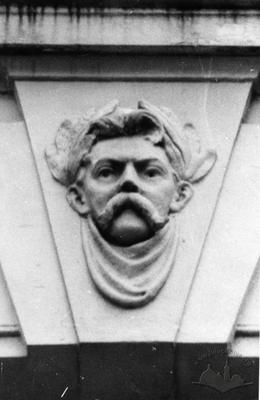Vul. Stepanivny – former residential building
This house on Stepanivny street looks like a palace. It was built in 1901 by builders Kasper Julian Draniewicz and Stanisław Dec for the family of colonel Jerzy Bulharyn and his wife Malwina. The building is an example of Historicist architecture. It is an architectural monument of local significance (no. 2812). Today the building is not used and is in ruins.
Architecture
The two-storied house with basements is rectangular in plan, built of brick and plastered; it has a high roof covered with tin, a masonry verandah at the east façade and a small wing attached to the south façade.
The building's architectural design is in the Neo-Baroque style; however, some stylized elements were strongly influenced by the Secession predominant in the early 20th c. The house has three façades, including two representative ones: the north one (overlooking the street) and the main west one with the verandah. The rear, south façade is smooth and has ribbon balconies. The house is placed along the frontage line of the row housing on Stepanivny street. The main entrance is arranged from the courtyard through the verandah, which, along with a tracery brick parapet, a lucarne and window trimmings provide the townhouse with a distinct Neo-Baroque nature. The façades are emphasized by a high plastered semibasement with windows, topped with a wide stringcourse on modillions, with a belt of eggs-and-darts and a frieze with oval attic windows in Neo-Baroque trimmings. The ground floor façades are decorated with banded rustication and separated by a stringcourse between the tiers; the second floor façades are smooth. Each façade has three axes, the extreme window axis on the north façade and two axes on the east façade are accentuated by pilasters with Ionic capitals on the second floor and Secession stylized consoles on the ground floor; the east part is crowned by an attic in the shape of a tracery parapet, with a lucarne in the middle. Wide profiled window trimmings with keystones decorated with male mascarons (ground floor) and broken Secession pediments (second floor), emphasize the Neo-Baroque and Secession nature of the townhouse.
The main entrance to the house is designed as a stone verandah supported by three columns and two semicircular arches. It can be entered via stone stairs with wheeling steps fenced with a balustrade. Above the verandah, there is a balcony with a tracery stone parapet and vases. The interior layout belongs to the corridor and enfilade type.
The townhouse is one of the best examples of Lviv's housing of the late Historicist period featuring Secession elements.
Personalities
Jerzy Bulharyn (1844–1913) — colonel, co-owner of the building in earlt 20th century
Jan Hrebeniak — a master builder
Stanisław Dec — a master builder who designed apartment houses in Lviv, and was the designer of this house
Kasper Julian Draniewicz (1867– after1939) — a licensed master builder from 1895 a and designer of a number of apartment houses in Lviv, he owned a workshop for architectural decor production, he designed this building
Karol Kuźniarz — a wealthy railroad official, who owned this building in 1913-1939
Edmund Pliszewski — a Lviv sculptor
Sałomon Riemer — architect who designed many apartment houses in Lviv
Olena Stepaniv/ Olena Stepanivna — a chotar of the Ukrainian Galician Army, a historian, geographer, public and military figure, the world's first woman officially enlisted in the army as a commissioned officer
Emil Schenk — owner of the ground plot before the construction of this house
Eugeniusz Szynkiewicz — resident of Kordeckiego street (now vul. Stepanivny)
Sources
2. 1936 map of Lviv
3. 1861 map of Lviv
4. 1878 map of Lviv
5. 1895 map of Lviv
6. Юрій Бірюльов "Драневич Каспер Юліан", Енциклопедія Львова, за ред. А. Козицького та І. Підкови, Т.2, (Львів: Літопис, 2007), 150.
7. Борис Мельник, Довідник перейменувань вулиць і площ Львова (Львів: Світ, 2001).
8. Gazeta Lwowska, 1908, № 43.
9. Jakub Lewicki, Między tradycją a nowoczesnością. Architektura Lwowa lat 1893-1918 (Warszawa, 2005).
Media Archive Materials
Related Pictures















